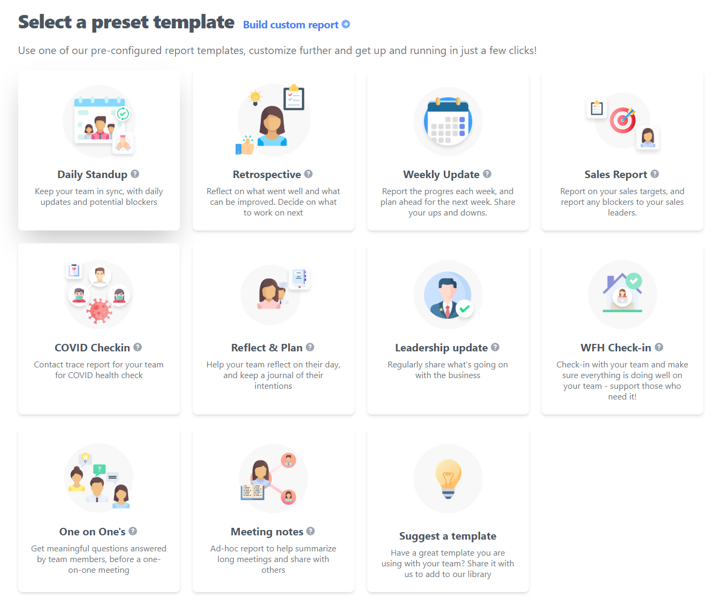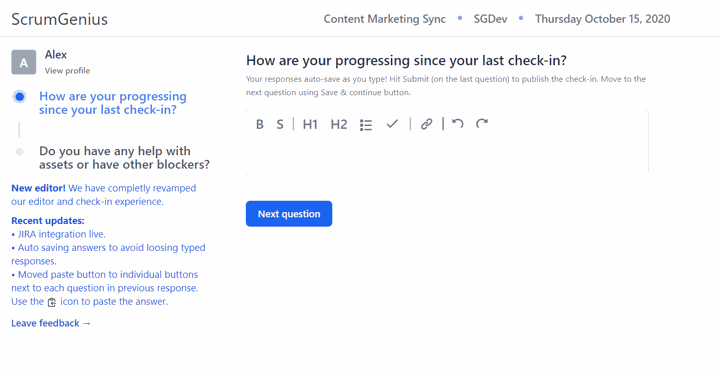
At ScrumGenius, we're all about helping people take back their standup meetings to boost communication, productivity and company morale. And while we've discussed the benefits of daily standup meetings and other agile meetings before, it's important to look into what they are and why they can help you with a little more depth.
What Is A Daily Standup Meeting?
A daily standup or daily scrum is a type of status update meeting where a team all meets at the same time to discuss their completed tasks, future goals and blockers in order to stay on top of work. Many companies use daily meetings to boost their productivity and foster better communication between team members as well.
Before we discuss standup meetings, we should first explain agile and scrum systems. Agile is an organizational system used by many companies to monitor work and help employees stay on track, and scrum workflows work within these larger systems.
The word “scrum” was first used in a 1986 essay by Takeuchi and Nonaka titled “The New New Product Development Game”, which argued that companies need to embrace speed and flexibility to be competitive. For them, Scrum systems offered a new way of managing a company's resources and getting better value out of teams and project managers.
The first daily standup was run in 1993 by Jeff Sutherland and his team at the Easel Corporation. He showed his employees a video of the New Zealand All Blacks rugby team, who performed a Maori warrior ceremony before each game to help team cohesion and improve morale, and eventually adopted a meeting style to help recreate the same spirit seen in that video.
How Can Daily Standups Help You?
Daily standup meetings and daily scrum meetings can help a variety of teams in different ways, but they can be best for medium-sized, fast-paced agile teams that work on multiple projects at once. Furthermore, they can also be very helpful for distributed or remote teams, especially in the form of asynchronous standups over chat or video meeting platforms like Zoom.
Daily standups have three main functions: planning, blocker-busting, and team bonding. While the first two are more obvious—talking about what you're working on and future goals help everyone stay organized, and discussing blockers means problems get solved easier—standups can also help improve team culture.
By having scheduled meetings where everyone discusses their work, teams can feel closer, in turn making collaboration and communication between colleagues even easier than before.
These daily scrum meetings can also have huge benefits. As they allow entire teams to get easy information on current tasks, goals and any potential blockers, they can make communication better—and in turn, save time as team members and leaders don't have to waste time trying to get status updates.
4 Common Issues with Daily Standups
Though daily standups can be incredibly helpful for many, they can also negatively affect your team's productivity if they aren't done correctly. There are many common pitfalls teams can run into that can make standups seem unproductive, so we're here to tell you how to fix that.
Your Standups Are Running Too Long
If you don't keep an eye on your standups' length, they can easily go too long and actually waste time instead of making your team more productive. One way to get around this is to make sure everyone has a strict time limit, so that way they know to condense down to the most important updates. Making sure everyone is prepared for the daily standup can also help, as it means that everyone on your team has an idea of what to say instead of trying to figure it out as they go.
Discussions Are Unfocused
It's very easy for standups to get off-track, meaning important info can slip through the cracks and get missed. The best way to fix this is by making sure everyone comes to standup meetings prepared. While this might sound daunting, it's as simple as having everyone write down their tasks, goals and blockers before the meeting so that way they have a checklist of what to discuss. You can even use a digital standup platform—more on that later—to capture these details for you.
You're Not Tackling Blockers
While discussing completed tasks and goals, important blockers can often fall to the wayside. That means any problems you may come across won't get solved, dragging down your productivity even more. That's why it's important to put a focus on these potential blockers to make sure your team tackles problems in a timely manner and you can keep your workflow running smoothly.
You're Trying A One-Size-Fits-All Approach
Most of the info you might find on how to run standups is very similar: short, fifteen-minute meetings at the beginning of the day to get the workday on track. But that's not true. Every team is different, and may have different needs. Some perform better with first-thing meetings, some with standups at the end of the day. You'll have to do the work to try and find out what works best for you and your team.
How to Run Your Best Daily Standups
Now that we've gone over some of the common problems with standups, let's go over how to run your best daily standup meetings and maximize your team's productivity.
Use Question Templates
Daily standups work best when you know what to talk about. One of the best ways to do this is to have a dedicated set of questions to ask every standup in order to get the most important information out of your team.
Often, this comes in the same standard format: what are you currently working on, what will you be working on next and what your blockers. But you can also customize these daily standup questions to fit your team even better.
For instance, if you manage a customer service team, you can add a question on how many tickets each person has in their queue. Likewise, if you're in a software development team, you can add a question about any potential bugs your team might encounter in the code.
To see more customized report templates, check out our templates page.

Customize Time Limits
Like we've already pointed out, daily standup meetings can easily become a hindrance when they run too long and waste time. In order to prevent this, we suggest setting strict time limits either to the amount of time each person is given to speak or the length of the standup meeting in general.
Keep a Specific Routine
Likewise, it's also important to make sure your meetings stick to a strict schedule so your team can be as prepared as possible to give their standups. This means holding standup meetings at the same time every day to create a routine that your team can count on.
Prepare and Take Notes
Another easy but important way to optimize your standups is to prepare for the meetings themselves as well as take notes while they're going on. We don't mean you have to fully write out your standup responses before
There are many easy manual ways to do this, such as through Excel sheets or Word documents, emails, or even with the use of project management tools such as Trello. But there are also automated ways to do so, which we'll talk about a little more later.
Furthermore, taking notes also allows you to keep better track of your team's progress. Using the standup questions as benchmarks allows you to easily compare day-to-day productivity and locate any potential issues.
How to Run Asynchronous Standups With ScrumGenius
One of the easiest ways to run your daily standups is to use an automated, asynchronous standup tool like ScrumGenius to do the heavy lifting for you. The ScrumGenius bot sends reminders to your team at a specific time each day to fill out their digital standups. Usually, this comes in the form of three short questions to capture metrics on your tasks, goals and blockers, but these questions can also be customized to best fit your team.

Though bots like ScrumGenius' can help take most of the work out of standups, they can also be used in conjunction with daily or even weekly in-person standups to boost communication even more.
But that's not it. Remember how we discussed preparing for the meeting beforehand so you know what to say? ScrumGenius makes that easy by giving you a rough draft to work with. You can also go back after your in-person standups and add any details you may have forgotten, giving yourself a record to look back on.
For more info on how to use ScrumGenius to maximize your daily standups, check out our 4 Steps to Success article.
